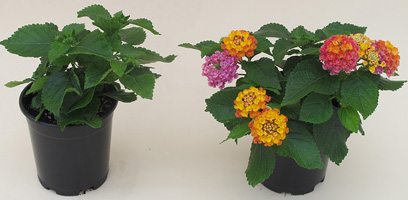12/30/2013
Cutting Time = A Quicker Turnaround
Karl Trellinger

Introduced at the 2013 California Spring Trials, the Cutting Time Callused Cutting Program from Syngenta Flowers, Inc. offers a major expansion of vegetative callused cuttings. Developed to help growers increase their profits while simplifying their work, the series in the Cutting Time program maintain the same reliable quality that growers find in all Syngenta products, but result in quicker production time.
Pictured: Lantana Bandana Cherry Sunrise unrooted cutting on the left and a Cutting Time callused cutting on the right eight weeks after sticking.
To eliminate the first stage of rooting, cuttings arrive callused, allowing you to directly stick them into their final container or propagation unit. Compared to unrooted cuttings (URCs), cuttings from the Cutting Time program lead to increased uniformity, fewer losses and reduced crop time by an average of two to three weeks.
Before they’re shipped, Cutting Time callused cuttings (CCs) are screened twice to guarantee uniformity. Upon arrival, cuttings require less mist both in frequency and duration. Even in less-than-optimal propagation conditions, CCs display less shrinkage and have a shorter production time compared to URCs.
Since many varieties included in Cutting Time are traditionally hard to propagate, production is much simpler for growers. Currently, the program includes:
- Bandana and Bandito Lantana
- Bombay Scaevola
- Nirvana and Nirvana Cascade Vinca
- Rio Dipladenia
- Sunrita Gaillardia
- Scentropia Heliotrope
- Tradewinds Osteospermum
- Full portfolio of geraniums and poinsettias
Propagation of callused cuttings in final container
It’s important to start in a clean area with a moisture level of 4. Upon arrival, direct stick the CCs with the same priority order as you use for URCs, and apply enough mist regularly throughout the day to ensure the leaves are hydrated. To avoid excessive leaf yellowing and loss of cuttings, stick Bandana and Bandito lantanas and Scentropia heliotrope with the highest priority. After this, spray cuttings immediately with CapSil spray adjuvant at 2 to 4 oz./100 gal. to improve water absorption into the leaf tissue.
During days 2 through 6, use a light mist as needed, and evaluate every 45 to 60 minutes, depending on environmental conditions. It’s important to avoid wilting of the CCs. To reduce mist frequencies, shade cloth can be used to achieve less than 2,000 foot candles (6 mols/day). Covering cuttings with Reemay fabric or plastic at night will reduce stress.
On day 6, CCs should be rooting into the growing media and light misting can likely be stopped. You can test several plants with a “gentle tug” to evaluate development. If rooting has started, remove any shade cloth you may have used and apply first fertilization at 150 ppm N using a Cal-Mag fertilizer formulation (15-5-15, 14-4-14, etc.).
During this first week, Daconil Ultrex or Heritage fungicides can be sprayed for foliar disease prevention, while Citation insect growth regulator or Exhibitline sf beneficial nematodes can be used to control fungus gnats.
It’s important to inspect frequently for whiteflies, aphids, thrips, fungus gnats, shore flies and diseases such as Botrytis and fungal root rots. If necessary, spray with Endeavor insecticide for control of aphids and whiteflies or drench with Flagship insecticide for broad-spectrum control of insects. Use Avid miticide/insecticide in rotation with other registered products for spider mites, thrips and whitefly control. To control foliar diseases, apply Palladium, Daconil Ultrex (prior to bloom) or Heritage fungicides on a seven to 14-day interval. Along with this, apply Heritage plus Micora fungicide via drench rotated with Subdue Maxx plus Medallion WDG fungicides as necessary to prevent root
diseases.
The Cutting Time program was developed and supported with growers in mind, and will give you the desired results to achieve efficient and economical production.
GT
Karl Trellinger is part of Technical Services for Syngenta Flowers, Inc.